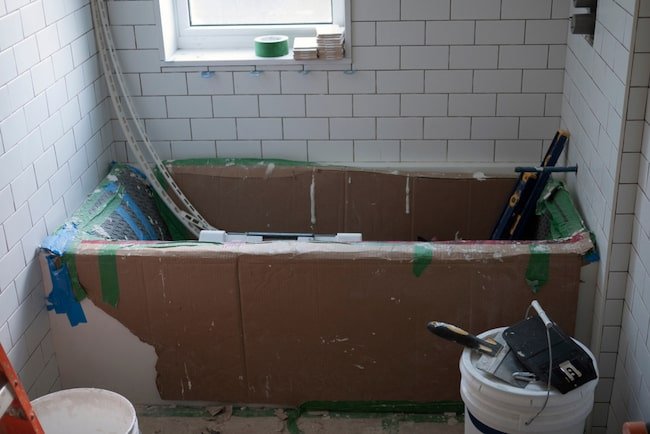Can I Install A Bath Tub Myself?
Can I Install A Bath Tub Myself?
Blog Article
We have uncovered this article about Installing A Bathtub listed below on the internet and reckoned it made good sense to relate it with you here.

Setting up a bath tub isn't precisely rocket science, but it does need solid plumbing, carpentry, as well as occasionally, tiling abilities. Changing an old bathtub with a new one is likewise a reasonably tough task. If the old bathtub is easily accessible, the job can relocate easily; if you need to open a wall surface to get rid of the old tub and also position the brand-new bathtub, the task is much harder. In either case, the project is within a house handyman's abilities, although you will certainly need an assistant to leave the old tub and also embeded in the new one. Make sure you have actually qualified yourself for the task and also fit trying it. As opposed to working with a service provider to take over a halfway-completed project, it is far better to take into consideration employing one before you begin. Opportunities are you might require a professional plumber to make tube connections.
This post will certainly assist you set up a new bathtub in your bathroom if you have already purchased a brand-new bathtub and don't need to transform the plan of your previous water pipelines.
Your devices as well as product checklist need to consist of the following:
Removing Old Touches
If you require to change old taps with new ones as a part of your installation, then the first thing you should do is detach the water system. After doing so, switch on the faucets to drain pipes any type of water remaining in the system. The process of eliminating the existing taps can be fairly problematic due to the restricted access that is commonly the instance.
Make use of a basin wrench (crowsfoot spanner) or a faucet device to reverse the nut that links the supply pipes to the taps. Have a towel prepared for the staying water that will originate from the pipes. When the supply pipelines have actually been gotten rid of, utilize the same tool to loosen up the nut that holds the faucets onto the bath/basin. You will need to quit the single taps from turning throughout this procedure. When the faucets have actually been gotten rid of, the holes in the bath/basin will need to be cleaned up of any kind of old sealing substance.
Before carrying on to fit the brand-new taps, contrast the pipe connections on the old taps to the new faucets. If the old taps are longer than the new taps, then a shank adapter is needed for the brand-new faucets to fit.
Fitting New Taps
If the tails of the brand-new faucets are plastic, then you will require a plastic connector to avoid damages to the string. One end of the connector fits on the plastic tail of the tap and also the various other end gives a link to the current supply pipes.
If you require to fit a monobloc, after that you will require lowering couplers, which attaches the 10mm pipeline of the monobloc to the typical 15mm supply pipe.
Next off, place the faucet in the placing hole in the bath/basin making sure that the washing machines remain in area between the tap as well as the sink. Secure the faucet in position with the manufacturer given backnut. When the faucet is safely in position, the supply pipes can be linked to the tails of the faucets. The taps can either be linked by utilizing corrugated copper piping or with regular faucet connectors. The former type ought to be linked to the faucet finishes initially, tightening only by hand. The supply pipes can later on be attached to the other end. Tighten both ends with a spanner after both ends have been attached.
Installing the Bath tub
Making use of the two wood boards under its feet, place the bathtub in the required placement. The wood boards are practical in evenly spreading the weight of the bath tub over the location of the boards as opposed to focusing all the weight onto four tiny factors.
The next goal is to guarantee that the tub is leveled all round. This can be attained by checking the level and also adjusting the feet on the bath tub until the spirit level checks out level.
To mount taps, fit the bottom of the furthest versatile tap connector to the appropriate supply pipeline by making a compression join; then do the exact same for the other faucet.
Activate the water system and also inspect all joints as well as new pipework for leaks as well as tighten them if required. Load the tub as well as additionally inspect the overflow electrical outlet as well as the normal outlet for leakages.
Finally, repair the bathroom paneling as explained in the maker's user's manual. Tiling and also securing around the bathtub needs to wait until the bathtub has been made use of at least once as this will settle it into its last setting.
Getting ready for the Setup
First of all, the supporting framework supplied with the bath needs to be fitted (if required) according to the supplier's instructions. Next off, fit the faucets or mixer to the bathtub. When suitable the tap block, it is essential to see to it that if the tap comes with a plastic washer, it is fitted between the bathroom and the faucets. On a plastic bath, it is additionally sensible to fit a supporting plate under the faucets device to avoid pressure on the tub.
Fit the flexible tap adapters to the bottom of the two faucets making use of 2 nuts and also olives (occasionally provided with the bathtub). Fit the plug-hole electrical outlet by smearing mastic filler round the sink electrical outlet hole, and then pass the outlet via the hole in the bathroom. Make use of the nut supplied by the maker to fit the plug-hole. Examine the plug-hole electrical outlet for an inlet on the side for the overflow pipe.
Next off, fit completion of the versatile overflow pipe to the overflow electrical outlet. After that, screw the pipeline to the overflow face which should be fitted inside the bathroom. Make certain you make use of every one of the supplied washing machines.
Attach the catch to the bottom of the waste outlet on the bath tub by winding the string of the waste electrical outlet with silicone mastic or PTFE tape, and screw on the trap to the outlet. Attach the bottom of the overflow tube in a comparable manner.The bath need to currently prepare to be suited its last position.
Tiling Around the Bathtub
In the location where the bathroom satisfies the floor tile, it is required to seal the joins with a silicone rubber caulking. This is very important as the installation can move enough to split a rigid seal, creating the water to pass through the wall between the bathroom and the tiling, bring about problems with wetness as well as possible leaks to the ceiling listed below.
You can choose from a range of coloured sealants to blend in your fixtures and installations. They are sold in tubes and also cartridges, and also can securing spaces up to a size of 3mm (1/8 inch). If you have a larger void to fill up, you can fill it with twists of soaked newspaper or soft rope. Keep in mind to constantly load the tub with water prior to securing, to permit the movement experienced when the bathtub is in use. The sealant can fracture fairly very early if you do not take into account this activity prior to securing.
Additionally, ceramic coving or quadrant floor tiles can be utilized to border the bath or shower tray. Plastic strips of coving, which are easy to use and also cut to dimension, are also conveniently offered on the marketplace. It is recommended to fit the tiles making use of water-resistant or water resistant sticky and also cement.
Bathtub Installation
How Important Is A Bathtub To Your Home?
High-quality baths, showers, and other bathroom updates are necessary when considering a smart investment in your home. It’s a room that you go to every day and one that is constantly being used by guests.The bathroom is one of the top trafficked rooms in a home and also one of the most valuable in terms of home resale.
Install Piping Before Tub
You will be using your existing drain and waste vent system, but pipes required include the hot and cold water supply lines and a pipe leading to a shower head. A mixing valve and shower head are also needed. Air chambers may be required.
Position the Tub
Lower the tub into place so that the continuous flange fits against the wall studs and rests on 1’x4' or 2’x4' supports. Anchor the tub to the enclosure with nails or screws inserted through the flanges into the studs.
NOTE: Remember, bathtubs and shower stalls may require support framing. A bathtub filled with water is extremely heavy, so check building codes and framing support before installing the tub.
Assemble Drain Connections
Assemble the bathtub drain connections by connecting the tub overflow with the tub drain above the trap, not beyond it. The trap will have a compression fitting that screws over the arm of the overflow assembly.
Place a Pipe For the Shower Head
First, locate a brass female threaded winged fitting and attach it to a framing support via a screw or a nail. Then run a pipe up the wall for the shower head. Sweat or solder the other side of the brass fitting to the top of the pipe.
Attaching Hot and Cold Water Lines
Attach your water lines for both hot and cold by sweating these directly into the hot and cold ports of the mixing valve. The mixing valve will be how water enters the tub’s system, not by the pipes themselves.
Install the Spout
Extend a piece of 1/2 inch pipe, or whichever length is specified in the manufacturer’s instructions, for the tub spout. Sweat on a male threaded fitting at the end of the pipe or use a brass nipple of the proper length and a 1/2 inch cap.
NOTE: At this point you should have your rough-in plumbing work inspected before proceeding further.
Check For Leaks
Restore the water pressure and check the drain connection and the supply pipes for any sign of leaking.
estore the Bathroom Wall
Replace the wall with moisture-resistant drywall as a base for your wall covering. Seal the joints between the wall and your new tub with silicone caulk as protection against water seepage.
https://www.berkeys.com/2016/12/02/bathtub-installation-dallas/

I ran across that piece of writing about Tools You Need to Install a New Bathtub when doing research the search engines. Enjoyed our piece? Please share it. Let somebody else locate it. Kudos for your time. Visit again soon.
Customer Reviews
Report this page